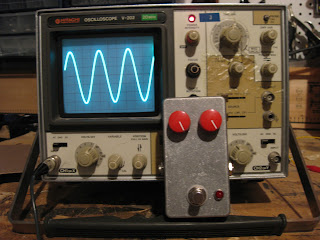I've had a few days to play with this pedal a little more. If there is one thing I can say about this pedal, it is the most unique overdrive tone I own. This thing boosts all the right frequencies. It an overdrive/fuzz hybrid kind of sound. When you turn it on, the first thing you notice is the chunky low end yet clear high end. It's fuzzyer on the low strings but overdriven on the high strings. This pedal is really dynamic with picking attack. It works great with your volume and tone knob as well with the amp tone controls. Also the volume control is get's really loud....like ear piercing. It can really push your amp to the extreme. So the sound of this beast is very unique, in a good way, and musical. Its great for a fuzzy tube amp kind of sound, almost like a tweed tone. This pedal is based on Craig Anderson's Tube Sound Fuzz circuit.
Ok so this project wasn't too hard to build but it did have it's challenges. Soldering was easier than last time, there were no diodes so I couldn't overheat anything. But the hardest part was fitting everything in the smallest enclosure I've ever worked with.
At the end of the day it worked out well
But soldering the wires from the board to the pot lugs was a challenge because it was such a small space. I'm going to need to find a better way of do this part
Other than that part, the rest was really fun to buildHere are some classy shots of the Way Huge Red Llama clone
Thats not the actual wave form of the red llama, just a regular sign wave.
I was thinking about doing a post about how pedals work. I would call it "how does it work" and I would explain how each component works together to create that given effect. I know a little about op amp and high pass filters, but I would love to learn more about circuitry and how it works.











A how's this work post would be great, but the red llama uses cmos gates, not op amps, right? That is a sweet looking pedal, the knobs look great. But you beat me to it! I still haven't ordered parts yet
ReplyDeleteYah, I finally had a good experience with shipping. And yes, the ic chip is CMOS. The inverter is actually based on a FET circuitry, so distorting it gives a tube like sound. Thanks for the input on the "How does it work" idea, I'll get started on it
Delete